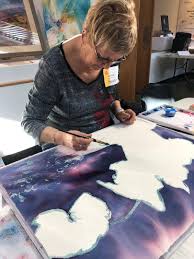The Benefits of Professional Painting Courses Online
Professional painting courses online have revolutionized the way aspiring artists can learn and improve their skills from the comfort of their own homes. With the advancement of technology and the rise of online education platforms, artists now have access to high-quality instruction, feedback, and resources that were once only available in traditional art schools.
Convenience and Flexibility
One of the key advantages of taking professional painting courses online is the convenience and flexibility they offer. Students can access course materials, tutorials, and assignments at any time that suits their schedule, allowing them to learn at their own pace without being tied to a specific location or class time.
Expert Instruction
Many online painting courses are taught by experienced professional artists who provide valuable insights, techniques, and guidance to help students develop their skills. Through video demonstrations, live critiques, and personalized feedback, students can receive individualized attention and support to enhance their artistic abilities.
Diverse Learning Opportunities
Online painting courses cover a wide range of topics and styles, catering to artists of all levels – from beginners looking to explore basic techniques to advanced painters seeking to refine their craft. Students have the opportunity to experiment with different mediums, subjects, and artistic approaches under the guidance of knowledgeable instructors.
Community Engagement
Despite being virtual, online painting courses foster a sense of community among students through discussion forums, group projects, and collaborative activities. Artists can connect with peers from around the world, share ideas, receive constructive criticism, and build a supportive network that encourages growth and creativity.
Enhanced Skills Development
By enrolling in professional painting courses online, artists can continuously challenge themselves, expand their artistic horizons, and refine their technical abilities through structured lessons and practice exercises. With access to resources such as video tutorials, e-books, reference materials, and interactive tools, students can deepen their understanding of art theory and practical application.
Conclusion
In conclusion, professional painting courses online offer a dynamic and accessible way for artists to hone their craft, connect with like-minded individuals,and unlock their creative potential in a supportive learning environment.
Top 5 FAQs About Enrolling in Professional Online Painting Courses
- 1. What are the prerequisites for enrolling in professional painting courses online?
- 2. How do online painting courses differ from traditional art school programs?
- 3. Are online painting courses suitable for beginners with no prior experience?
- 4. What types of painting techniques and styles are covered in professional online courses?
- 5. How can students receive feedback and support from instructors in virtual painting classes?
1. What are the prerequisites for enrolling in professional painting courses online?
To enroll in professional painting courses online, the prerequisites may vary depending on the specific course or program. Generally, most online painting courses welcome students of all skill levels, from beginners to experienced artists. Some courses may require basic knowledge of art fundamentals such as color theory, composition, and drawing techniques, while others may be tailored for complete novices looking to explore the world of painting. It is advisable to review the course descriptions and requirements provided by the online platform or institution offering the program to ensure that you meet any prerequisites or recommendations before enrolling.
2. How do online painting courses differ from traditional art school programs?
Online painting courses differ from traditional art school programs in several key ways. While traditional art school programs often require students to attend classes in person at specific times and locations, online painting courses offer flexibility and convenience by allowing students to learn at their own pace and on their own schedule. Additionally, online courses provide access to a diverse range of instructors, techniques, and styles from around the world, whereas traditional art schools may have a more limited curriculum based on their faculty and resources. Online painting courses also tend to be more affordable and accessible, making them an attractive option for artists looking to develop their skills without the constraints of a traditional classroom setting.
3. Are online painting courses suitable for beginners with no prior experience?
Online painting courses are highly suitable for beginners with no prior experience in art. These courses are designed to cater to students at all skill levels, including those who are just starting their artistic journey. Beginners can benefit from step-by-step instructions, foundational lessons, and hands-on practice exercises that help them build a solid understanding of basic techniques and concepts. Additionally, online painting courses often provide access to supportive communities, expert guidance from instructors, and resources tailored to beginners’ needs, making it easier for novices to learn and grow in a welcoming and encouraging environment.
4. What types of painting techniques and styles are covered in professional online courses?
Professional online painting courses typically cover a wide range of painting techniques and styles to cater to the diverse interests and skill levels of students. From traditional methods such as oil painting, watercolor, acrylics, and pastels to contemporary approaches like mixed media, abstract art, impressionism, and realism, students have the opportunity to explore various artistic styles under the guidance of experienced instructors. Additionally, courses may delve into specialized techniques such as color theory, composition, texture application, brushwork, and perspective drawing to help students develop a versatile skill set and express their creativity in unique ways.
5. How can students receive feedback and support from instructors in virtual painting classes?
In virtual painting classes, students can receive feedback and support from instructors through various interactive methods. Typically, instructors provide personalized critiques on students’ artwork through video demonstrations, written comments, and virtual meetings. Students can also participate in live Q&A sessions, group discussions, and peer reviews to receive constructive feedback from both instructors and fellow artists. Additionally, many online platforms offer messaging systems or forums where students can ask questions, share their work-in-progress, and engage in ongoing dialogue with instructors for continuous guidance and support throughout their learning journey.

